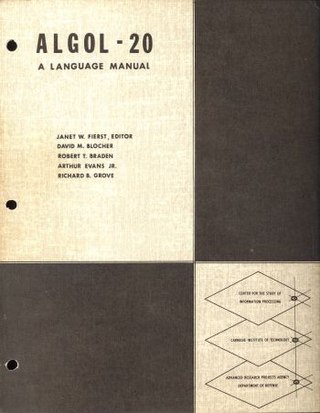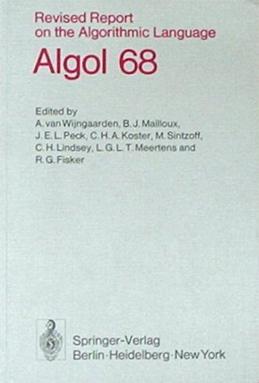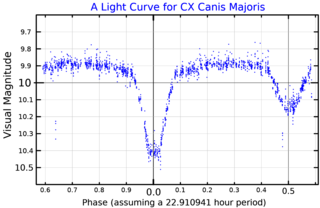
Algol, designated Beta Persei, known colloquially as the Demon Star, is a bright multiple star in the constellation of Perseus and one of the first non-nova variable stars to be discovered.

ALGOL is a family of imperative computer programming languages originally developed in 1958. ALGOL heavily influenced many other languages and was the standard method for algorithm description used by the Association for Computing Machinery (ACM) in textbooks and academic sources for more than thirty years.
ALGOL W is a programming language. It is based on a proposal for ALGOL X by Niklaus Wirth and Tony Hoare as a successor to ALGOL 60. ALGOL W is a relatively simple upgrade of the original ALGOL 60, adding string, bitstring, complex number and reference to record data types and call-by-result passing of parameters, introducing the while statement, replacing switch with the case statement, and generally tightening up the language.
Non-English-based programming languages are programming languages that do not use keywords taken from or inspired by English vocabulary.
ALGOL 60 is a member of the ALGOL family of computer programming languages. It followed on from ALGOL 58 which had introduced code blocks and the begin and end pairs for delimiting them, representing a key advance in the rise of structured programming. ALGOL 60 was one of the first languages implementing function definitions. ALGOL 60 function definitions could be nested within one another, with lexical scope. It gave rise to many other languages, including CPL, PL/I, Simula, BCPL, B, Pascal, and C. Practically every computer of the era had a systems programming language based on ALGOL 60 concepts.

ALGOL 68 is an imperative programming language that was conceived as a successor to the ALGOL 60 programming language, designed with the goal of a much wider scope of application and more rigorously defined syntax and semantics.
Modular programming is a software design technique that emphasizes separating the functionality of a program into independent, interchangeable modules, such that each contains everything necessary to execute only one aspect of the desired functionality.
ALGOL 58, originally named IAL, is one of the family of ALGOL computer programming languages. It was an early compromise design soon superseded by ALGOL 60. According to John Backus
The Zurich ACM-GAMM Conference had two principal motives in proposing the IAL: (a) To provide a means of communicating numerical methods and other procedures between people, and (b) To provide a means of realizing a stated process on a variety of machines...
ALGOL X was the code name given to a programming language which was being developed as a successor to ALGOL 60, by the International Federation for Information Processing (IFIP) IFIP Working Group 2.1 on Algorithmic Languages and Calculi, which supports and maintains the languages ALGOL 60 and ALGOL 68. It attempted to find a "short-term solution to existing difficulties". ALGOL N and ALGOL W were two other ALGOL versions proposed to fulfill this need.
ALGOL N (N for Nippon – Japan in Japanese) is the name of a successor programming language to ALGOL 60, designed in Japan with the goal of being as simple as ALGOL 60 but as powerful as ALGOL 68. The language was proposed by Nobuo Yoneda. ALGOL N tried to use extensibility to solve the problem that language designers faced when trying to make an inextensible language for all domains, or having to make many domain-specific languages (DSLs), one for each domain. It avoided type conversion (coercion) while not making things more difficult for programmers.
ALGOL Y was the name given to a speculated successor for the ALGOL 60 programming language that incorporated some radical features that were rejected for ALGOL 68 and ALGOL X. ALGOL Y was intended to be a "radical reconstruction" of ALGOL.
The man or boy test was proposed by computer scientist Donald Knuth as a means of evaluating implementations of the ALGOL 60 programming language. The aim of the test was to distinguish compilers that correctly implemented "recursion and non-local references" from those that did not.
There are quite a few ALGOL60 translators in existence which have been designed to handle recursion and non-local references properly, and I thought perhaps a little test-program may be of value. Hence I have written the following simple routine, which may separate the man-compilers from the boy-compilers.

USS Algol (AKA-54) was an Andromeda-class attack cargo ship. She was the first ship of the United States Navy by this name, after Algol, a fixed star in the constellation Perseus. Algol served as a commissioned ship for 22 years and 1 month.
ALGOL 68RS is the second ALGOL 68 compiler written by I. F. Currie and J. D. Morrison, at the Royal Signals and Radar Establishment (RSRE). Unlike the earlier ALGOL 68-R, it was designed to be portable, and implemented the language of the Revised Report.

Willem Louis van der Poel is a Dutch computer scientist, who is known for designing one of the first computers to be designed in the Netherlands, the Zeer Eenvoudige Binaire Reken Automaat (ZEBRA), translated as Very Simple Binary Automatic Calculator.
IFIP Working Group 2.1 on Algorithmic Languages and Calculi is a working group of the International Federation for Information Processing (IFIP).

CX CMa is a blue variable star in the Canis Major constellation. Discovery of this variable is usually credited to German Astronomer Cuno Hoffmeister in 1931, although this remains uncertain.

HD 139319 is a ternary system composed of the binary Algol variable star known as TW Draconis, and a main-sequence companion star at a separation of 3 arcseconds. The system lies in the constellation of Draco about 540 light years away.

VV Ursae Majoris is a binary star system in the northern circumpolar constellation of Ursa Major, abbreviated VV UMa. It is a variable star system with a brightness that cycles around an apparent visual magnitude of 10.19, making it too faint to be visible to the naked eye. The system is located at a distance of approximately 1,500 light years based on parallax measurements.

RT Persei is a variable star system in the northern constellation of Perseus, abbreviated RT Per. It is an eclipsing binary system with an orbital period of 0.84940032 d (20.386 h). At peak brightness the system has an apparent visual magnitude of 10.46, which is too faint to be viewed with the naked eye. During the eclipse of the primary this decreases to magnitude 11.74, then to magnitude 10.67 with the secondary eclipse. The distance to this system is approximately 628 light years based on parallax measurements. It is drifting closer with a heliocentric radial velocity of about −12 km/s.








